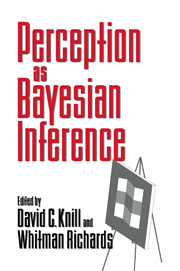Book contents
- Frontmatter
- Contents
- List of contributors
- Preface
- 0 Introduction
- Part one Bayesian frameworks
- 1 Pattern theory: A unifying perspective
- 2 Modal structure and reliable inference
- 3 Priors, preferences and categorical percepts
- 4 Bayesian decision theory and psychophysics
- 5 Observer theory, Bayes theory, and psychophysics
- Commentaries
- Part two Implications and applications
- Commentaries
- Author index
- Subject index
5 - Observer theory, Bayes theory, and psychophysics
Published online by Cambridge University Press: 05 March 2012
- Frontmatter
- Contents
- List of contributors
- Preface
- 0 Introduction
- Part one Bayesian frameworks
- 1 Pattern theory: A unifying perspective
- 2 Modal structure and reliable inference
- 3 Priors, preferences and categorical percepts
- 4 Bayesian decision theory and psychophysics
- 5 Observer theory, Bayes theory, and psychophysics
- Commentaries
- Part two Implications and applications
- Commentaries
- Author index
- Subject index
Summary
Introduction
The search is on for a general theory of perception. As the papers in this volume indicate, many perceptual researchers now seek a conceptual framework and a general formalism to help them solve specific problems.
One candidate framework is “observer theory” (Bennett, Hoffman, & Prakash, 1989a). This paper discusses observer theory, gives a sympathetic analysis of its candidacy, describes its relationship to standard Bayesian analysis, and uses it to develop a new account of the relationship between computational theories and psychophysical data. Observer theory provides powerful tools for the perceptual theorist, psychophysicist, and philosopher. For the theorist it provides (1) a clean distinction between competence and performance, (2) clear goals and techniques for solving specific problems, and (3) a canonical format for presenting and analyzing proposed solutions. For the psychophysicist it provides techniques for assessing the psychological plausibility of theoretical solutions in the light of psychophysical data. And for the philosopher it provides conceptual tools for investigating the relationship of sensory experience to the material world.
Observer theory relates to Bayesian approaches as follows. In Bayesian approaches to vision one is given an image (or small collection of images), and a central goal is to compute the probability of various scene interpretations for that image (or small collection of images). That is, a central goal is to compute a conditional probability measure, called the “posterior distribution”, which can be written p(Scene | Image) or, more briefly, p(S | I).
Information
- Type
- Chapter
- Information
- Perception as Bayesian Inference , pp. 163 - 212Publisher: Cambridge University PressPrint publication year: 1996
Accessibility standard: Unknown
Why this information is here
This section outlines the accessibility features of this content - including support for screen readers, full keyboard navigation and high-contrast display options. This may not be relevant for you.Accessibility Information
- 6
- Cited by
